There was a time, not so very long ago, when gardening consumed most of my free time and creativity. This was especially true when I first moved to a tumbledown-but-promising homestead in Pembroke in 2010. I eagerly established shrub borders, a butterfly garden, walkways, a patio, vegetable beds, container plantings, new trees, an apple orchard, a wildflower meadow . . . and looked forward to the shade and wetland gardens, when other interests and responsibilities lured me away. Neglect has, once again, taken hold.
Some plants died, others drifted, but many grew vigorously when left to their own devices. I pretended not to notice the towering weeds and unwanted saplings, the borders that have melted into lawn, the holes where something used to grow . . . until last week, when this display near my mailbox demanded attention. Yes, curiosity got the better of me.
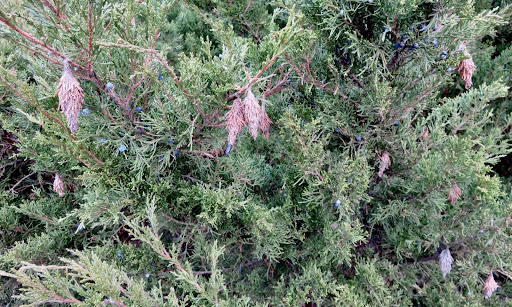
Dozens of tan ornaments now adorn the massive ‘Sea Green’ junipers which haven’t been pruned in four or five years. Until that fateful day, I hadn’t noticed anything askew, and clearly, these pendulous “cones” didn’t develop overnight. From a distance, they look like plausible extensions of the shrub’s anatomy – conical, tan-colored, and attached at the top to supportive branches – and this illusion serves their purpose. My batch of new “cones” are actually the protective cases of an unusual insect. The shrub’s real cones are those blue, berrylike structures.
While this particular species was new to me, I recognized the work of bagworms. As a child, I discovered some peculiar structures attached to our stockade fence. Why would someone glue twigs into the shape of an ice cream cone? And, why were they on the fence? Imagine my surprise when I discovered an insect living inside. Those long-ago cases, only ½ inch long, were probably constructed by common bagworm moths (Psyche casta). What’s living near my mailbox is MUCH larger, approximately 2 inches long. Evergreen bagworms (Thyridopteryx ephemeraeformis) made these larger cases. See the images below for size comparison.
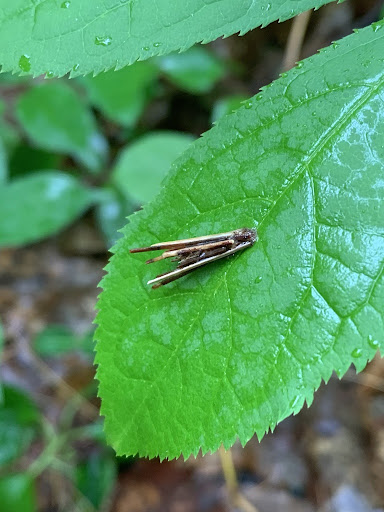
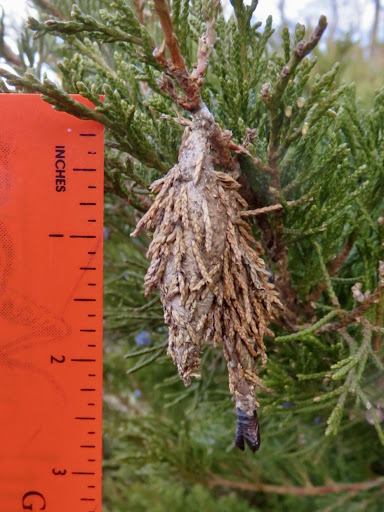 Common Bagworm Moth
Common Bagworm Moth© Bill MacIndewar,
some rights reserved (CC-BY-NC)
Evergreen Bagworm Moth, PembrokeServing as shield and camouflage, these spindle-shaped bags protect the moth during several life stages. The cases in my yard contain eggs, perhaps hundreds of eggs, for next spring’s caterpillars. Upon hatching and finding a suitable host plant, the tiny bagworm caterpillar will begin spinning a “cocoon-like bag to which it attaches pieces of plant leaves, needles, and twigs.” As a helpful UMass Extension factsheet explains, “Only the head and thorax of the caterpillar comes out of the bag, which is dragged along behind the insect as it moves.” By constructing this protective covering, the caterpillar looks like the plant upon which it feeds.
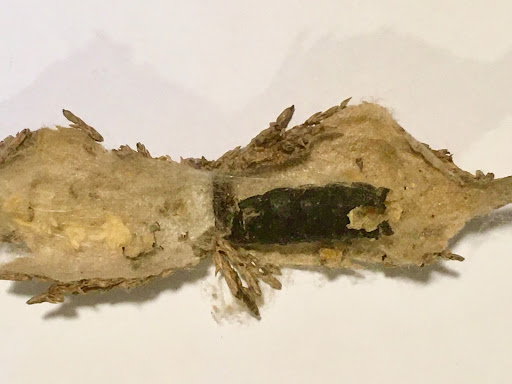
Inside the Bagworm’s Case
Both male and female moths pupate within their cases after attaching them securely to vegetation. As adults, the two sexes differ dramatically. The male is a dark, hairy moth with transparent wings. The female remains worm-like with “vestigial mouthparts and legs, small eyes, and no antennae or wings” according to the University of Florida. She spends her entire life within the bag that she constructed. This includes mating, egg-laying, and even dying. Talk about a homebody! As with many insects, the adult stage is quite short.
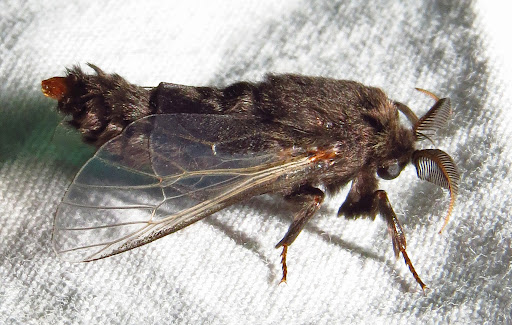
© David Dodd, some rights reserved (CC-BY)
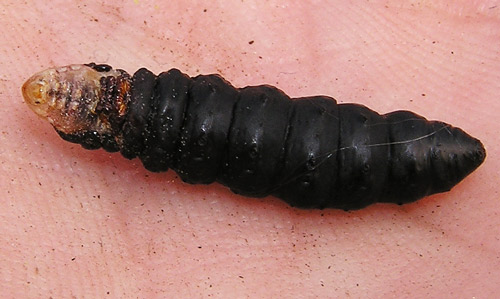
Evergreen Bagworm Female Adult
Curtis Young, Ohio State University
Via “Featured Creatures,” the University of Florida
This species is native to eastern North America. Based on reports through iNaturalist, populations seem to be highest in the mid-Atlantic, especially in urban areas where its natural predators (wasps and woodpeckers) are absent. Its preferred hosts are juniper and arborvitae, though it will feed on a variety of trees including some deciduous species.
As Clemson’s “Home & Garden Information Center” notes, “Most bagworm infestations result from stressed plants.” My juniper was no exception. It grows near a driveway and a busy road, and some heavy equipment had disrupted the soil near its base. Insects home in on weak plants. Bagworms may soon benefit from another type of disruption: climate change. Until recently, Massachusetts’ autumn frosts have killed evergreen bagworms before they pupate. I wonder if our unseasonally warm weather supported greater bagworm reproduction this year.
As a gardener and naturalist, I now face the question of what, if anything, should I do with these egg cases. Attitudes towards this species range from “detrimental insect pest” (Clemson) to “an interesting caterpillar” (Ohio State), and management strategies include everything from handpicking to malathion applications. Since I want to encourage native insect populations and keep my landscape plants alive, I appreciate the sensible advice offered by the Annapolis Native Plant Society. This group encourages preventative measures such as planting nectar-bearing plants to attract parasitic wasps. They also recommend planting mixed borders to limit caterpillar dispersal. Given that bagworm larvae can “balloon” from one tree to the next, monoculture hedgerows are particularly risky. I’ve been wondering which of my neighbors would enjoy bagworm eggs, and this article points me in the right direction: “There are also three common birdfeeder birds that are known to scavenge bagworm eggs from twigs and branches during the winter months: chickadees, nuthatches, and titmice.” I think bagworms will soon be on their menu.
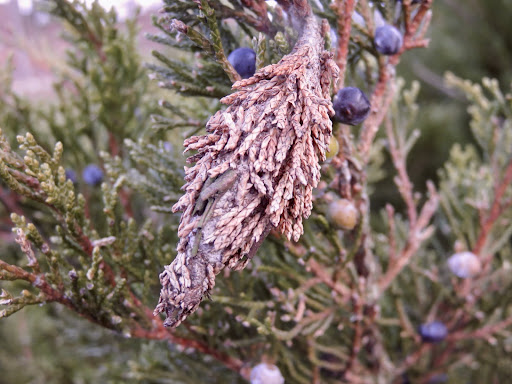
*****Reminder: “Picturing Winter,” the library’s photo contest, runs through January. Submit your images of ice and snow to lrubinacci@amesfreelibrary.org.